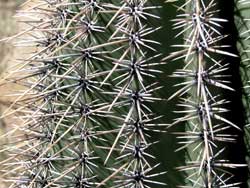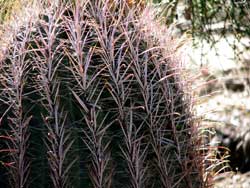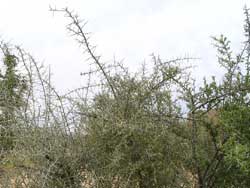BY JIM BLACKBURN | FEBRUARY 16, 2011
Our Desert
A Land of Thorns, prickles and spines
You’ve noticed that many of our desert plants have very effective coverings of sharp, pointed projections, primarily to defend themselves. A lot of terms are used to describe these projections, but I was never sure what term was appropriate for which, so I did a little investigation.
I found out that:
Thorns are very short hard leafless branches with very sharp points, Prickles are growths out of the bark or epidermis such as on a rose, and Spines are modifications of leaves, such as the tips of Agave and Yucca, and the projections growing out of the areoles on a cactus.
 And there are other terms such as Teeth on the leaf edges of some Agave. Glochid are the sharp, minute bristles or little hairs found in the areoles of the cactus family on prickly pears and chollas. Then there are always those less technical but more expressive terms like ouches, claws, barbs, hooks, and briars.
And there are other terms such as Teeth on the leaf edges of some Agave. Glochid are the sharp, minute bristles or little hairs found in the areoles of the cactus family on prickly pears and chollas. Then there are always those less technical but more expressive terms like ouches, claws, barbs, hooks, and briars.
You might wonder which projection has the worst “bite.” In my opinion, it’s the cholla. Particularly the Teddy Bear or more realistically the Jumping Cholla. It doesn’t really jump but the joint tips readily break off and magically attach themselves to whoever passes by.
These little ball-like stems or joints that release from the plant so easily are the ones our pack rats (white throated wood rats) collect to cover their nests, or middens. You’ve probably noticed these mounds while on hikes.
I vividly recall a time Pete and I were descending from an arduous climb to a nearby peak. I put a “sure” foot downhill of a pack rat’s nest but instead slipped. I put my hand out to the uphill side to catch my weight and unfortunately placed it into the midden’s covering of collected cholla discards. I knew at once I’d done wrong.
Pulling my hand back, I saw the handful and of course felt the pain immediately. Pete worried I might pass out on this treacherous slope. After a few moments of marveling at this handful, I dug out my trusty long-nose pliers. Tweezers just aren’t strong enough on cholla; you need a really aggressive hold. So we spent half an hour or so with one foot higher than the other on the slope, pulling one spine after another from my hand, each leaving a bloody red spot. When we finished, my hand looked like it had some sort of measles. The ranger urged a tetanus shot.
Another less suspected hazard is in the arroyos (drainages and washes). Cacti generally grow on the flats and hillsides, but in the arroyos are the broader-leafed plants, trees and thicker vegetation. As you push your way through this taller vegetation, you’re likely to brush into the Catclaw, often referred to as the “Wait-a-Minute” bush.
 My best recollection of a Catclaw encounter was again when with Pete who wears his fanny pack in the front and always carries a can of root beer in it. Wouldn’t you know! A thorn, probably a Catclaw, actually penetrated the can and soon he noticed the wetness down the front of his pants – most embarrassing!
My best recollection of a Catclaw encounter was again when with Pete who wears his fanny pack in the front and always carries a can of root beer in it. Wouldn’t you know! A thorn, probably a Catclaw, actually penetrated the can and soon he noticed the wetness down the front of his pants – most embarrassing!
Do spines serve strategies other than defense? Sure. They provide for shading the skin of the cactus. Oftentimes the spines can direct rainwater downward to the roots at the base of the plant. In the case of chollas they move a bit of the plant to another location for propagation of the species.
But how do birds, squirrels, pack rats and lizards climb over all those spines without getting stuck? Those creatures weigh very little and therefore the spines may not penetrate their skins. I looked up the weight of these little fellows we see scampering over a cactus. A mouse might weigh about an ounce at most, while a squirrel may be as heavy as a dozen ounces and a pack rat can be close to a pound.
Being a good physicist, I performed an experiment. I stuck a cholla spine upright in a bit of modeling clay onto my postal scale and then lowered my finger pad onto the point while observing the force to just stick the point into my finger. It took only about half an ounce! That’s less than the weight of a first class letter. I tried it again, sticking the point into the back of my hand with the same result. Using my fingernail, the spine tip broke at about two or so ounces and wouldn’t penetrate. The experiment showed it wasn’t only less weight that prevented penetration but that their skin must be a bit more resistant to penetration than mine.
 At home I made some close examinations of a cholla spine using my handy hand-held thirty-power microscope. Its tip is about one thousandth of an inch and has a very long taper to about one ten thousandth of an inch shaft. An ordinary pin is about three times bigger in diameter and has a much shorter taper to the point, five to ten times larger than the cholla point. It took about three ounces to make the pin stick to my finger. Also, under the microscope I discovered the cholla has two more special features. Covering the point is a protective sheath that slides back on penetration. And the shaft underneath is covered with numerous barbs under one thousandth of an inch in size, making it much more difficult to withdraw! No wonder the cholla spine is the most troublesome to pull out.
At home I made some close examinations of a cholla spine using my handy hand-held thirty-power microscope. Its tip is about one thousandth of an inch and has a very long taper to about one ten thousandth of an inch shaft. An ordinary pin is about three times bigger in diameter and has a much shorter taper to the point, five to ten times larger than the cholla point. It took about three ounces to make the pin stick to my finger. Also, under the microscope I discovered the cholla has two more special features. Covering the point is a protective sheath that slides back on penetration. And the shaft underneath is covered with numerous barbs under one thousandth of an inch in size, making it much more difficult to withdraw! No wonder the cholla spine is the most troublesome to pull out.
The glochids growing out of the areoles on some prickly pear are just as sharp as the tip of the cholla spine but smaller in diameter and collectively look like a very full pincushion with the points sticking out about one sixty-fourth of an inch or so, making them hard to see when stuck in the skin but easy to feel. Some people use sticky tape to help remove them.


